Canon Powershot A640 Review
Date: November 27th 2006
Author: Gavin Stoker
Leave a Comment about this Review
|
Image Quality
All of the sample images in this Review were taken using the 10 megapixel Superfine quality mode, which gives an average image size of around 4Mb - 5Mb.
Noise
There are 5 ISO settings available on the Canon Powershot A640 which you can select at any time if the camera is in any of the creative shooting modes. Here are some 100% crops which show the noise levels for each ISO setting. At the lower ISO settings there isn't a problem with image noise � though camera shake can be a problem if shooting handheld in dim lighting � and even though noise starts to creep in from ISO 400, maximum ISO 800 setting is still very usable.
ISO 80 (100% crop) |
ISO 100 (100% crop) |
 |
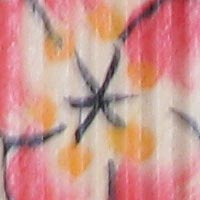 |
ISO 200 (100% crop) |
ISO 400 (100% crop) |
 |
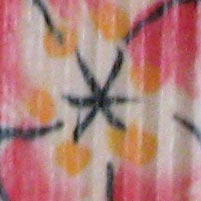 |
ISO 800 (100% crop) |
|
 |
|
Sharpening
Here are two 100% crops which have been Saved as Web - Quality 50 in Photoshop. The right-hand image has had some sharpening applied in Photoshop. The out-of-the camera images are a little soft at the default setting ideally and benefit from some further sharpening in a program like Adobe Photoshop. You can also change the in-camera sharpening level to suit your tastes via the My Colors menu option.
Original
(100% crop) |
Sharpened (100% crop) |
 |
 |
 |
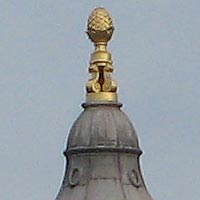 |
Chromatic Aberrations
The Canon Powershot A640 dealt exremely well with chromatic aberrations well during the review, with only very limited purple fringing present around the edges of objects in certain high-contrast situations, and only in a handful of test images.
| Chromatic
Aberrations (100% crop) |
 |
Macro
The Canon Powershot A640 offers a Macro setting that allows you to focus on a subject that is just 1cm away from the camera when the lens is set to wide-angle. The first image shows how close you can get to the subject (in this case a compact flash card). The second image is a 100% crop.
| Macro Shot |
Macro Shot (100% crop) |
 |
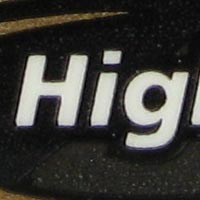 |
Flash
The flash settings on the Canon Powershot A640 are Auto, Manual Flash On / Off, Slow Sync Speed and Red-eye Reduction. These shots of a white coloured wall were taken at a distance of 1.5m.
| Flash Off - Wide Angle (35mm) |
Auto Flash - Wide Angle (35mm) |
 |
 |
| Flash Off - Telephoto (140mm) |
Auto Flash - Telephoto (140mm) |
 |
 |
And here are some self-portrait shots. If you opt to use flash for portraits, it's difficult to avoid the effects of red eye (despite the camera's anti red-eye flash setting).
| Flash On |
Flash On (100% Crop) |
 |
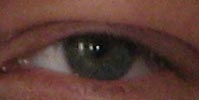 |
| Flash - Red-Eye Reduction |
Flash - Red-Eye Reduction (100% Crop) |
 |
 |
Night Shot
The Canon Powershot A640 maximum shutter speed is 15 seconds, which is great for night photography. The shot below was taken using a shutter speed of 1/5 second, f/2.8 at ISO 400. I've included a 100% crop of the image to show what the quality is like. The camera takes the same amount of time again to apply noise reduction, so for example at the 8 second setting the actual exposure takes 16 seconds.
| Night Shot |
Night Shot (100% crop) |
 |
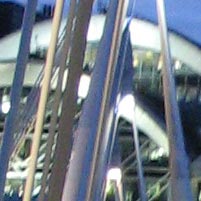 |
Overall Image Quality
Perhaps inevitably there is occasional visible camera shake and image softness when shooting at maximum telephoto setting � even in daylight. Under strong winter sun there's also the danger of lens flare and loss of detail in the highlights, though this is no better nor worse than competing brands. Pixel fringing, though noticeable on close inspection between areas of high contrast, isn't problematic, and overall images are sharp and clear with, for the most part, a pin sharp level of detail, even if to the naked eye they don't seem significantly better than those from a seven or eight megapixel compact. Perhaps the resolution of the LCD screen could be boosted (from 115k pixels), as it's tricky to determine whether a subject is sharply in focus when reviewing on the LCD alone. Still, colours are pleasingly naturalistic if slightly warm, with skin tones particularly flattering. And though greens and reds are already pretty vivid, there's of course also the opportunity to boost saturation in camera if needed. At the lower ISO settings there isn't a problem with image noise � though camera shake can be a problem if shooting handheld in dim lighting � and even though noise starts to creep in from ISO 400, maximum ISO 800 setting is still very usable. If, however, you do opt to use flash for portraits instead, it's difficult to avoid the effects of red eye (despite the camera's anti-red eye flash setting). To sum up, a performance that, while it may not be 100% successful, delivers the goods more often than not, making the Canon Powershot A640 a reliable and slightly more flexible choice of snapshot camera.
|
![]() PhotographyBLOG
is a member of the DIWA
organisation. Our test results for the Canon Powershot A640
have been submitted to DIWA
for comparison with test results for different samples of
the same camera model supplied by other DIWA
member sites.
PhotographyBLOG
is a member of the DIWA
organisation. Our test results for the Canon Powershot A640
have been submitted to DIWA
for comparison with test results for different samples of
the same camera model supplied by other DIWA
member sites.
